Chicken grazing boxes are wooden frames with wire mesh stapled to one side. Grazing boxes make it possible to grow grass even in crowded chicken runs because they protect the roots of grass from chicken scratches.
In this article, you’ll learn:
- How seeing an old furnace grate discarded in a field inspired me to make the first chicken grazing boxes in 2012.
- A shopping list of supplies you’ll need to build grazing boxes, a free printable PDF plan to print and take to your workshop, and a step by step tutorial to make your own grazing box,
- My grazing box planting advice advice, based on 10 years of using these grazing boxes in my chicken coops, including grass types that work best and tips on best placement.
Read on for a complete guide to everything you need to know to build and use chicken grazing boxes.

Our farm has long been home to chickens. Often they spend daylight hours free-ranging, but for various reasons, many days the chickens stay confined to their 100 year old coop and a 10 foot by 12 foot fenced run.
Early in my experience of chicken keeping, I was frustrated by chickens pulling up and eating any plant that sprouted in their enclosed run. Each spring, I’d try a new attempt at keeping even a portion of the run green, and usually fail. One year, I experimented with fences to “rest” sections of the run long enough to establish growth, however, my chickens had an impressive ability to move even well-anchored fencing. Although I found a combination of hacks that keep green growth in my coop year-round, my experiment with these elevated mesh boxes was so successful they’ve got their own tutorial below.
These chicken grazing boxes create a protective buffer between delicate root systems and the ravenous beaks and prehistoric scratching claws above. This riser provides just enough protection to young plants so that cool weather grasses can grow year-round, providing forage in winder months when free-ranging is more difficult.
My Grazing Boxes Experiment:
The following section may contain affiliate links. As an Amazon Associate, we earn from qualifying purchases.
Inspired by seeing stems of grass growing through a scrap metal grate in a scrapyard, in 2011 I decided to experiment with small sections of hardware cloth (wire mesh with openings about 1/4″ x 1/4″ wide) that I had leftover after another project, stapled over a 2×4 frame. The elevated design prevents the chickens from damaging the roots of the grass.
This is one of the easiest DIY’s I’ve ever built! I’ve outlined steps below, but essentially you’ll just need to make frames with 2×4’s, and add supports every 12-16 inches to prevent heavy hens from forcing the mesh top to sag (which would allow beaks to damage the grass underneath.) With the hardware cloth firmly stapled to the frames, these frames help provide my chickens with fresh grass for 9-10 months out of the year. When finished, planted, and sprouted, the chickens neatly “mow” the grass, through the mesh, without damaging the roots.
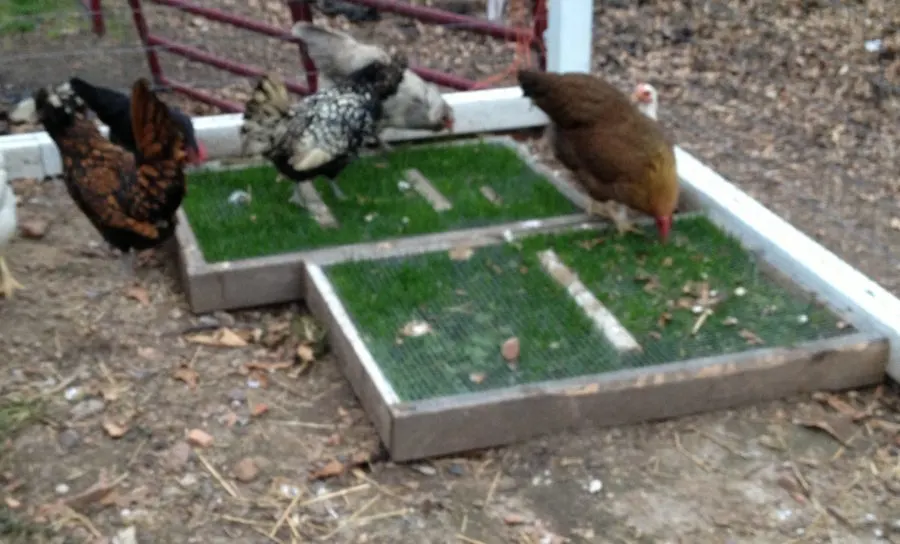
How to Build Chicken Grazing Boxes:
Supplies You’ll Need:
- 2×4 Lumber (Pressure Treated will last longer) To make the boxes light enough to move easily, cut down to lengths of 24 inches and 18 inches. Save your scraps for the final step.
- A Kreg Jig (use for most sturdy construction) or Corner Brackets (flimsier and may require corner braces)
- Staple Gun (did you know electric staple guns are a thing? They are, and they are AWESOME)
- 1/4″ Opening Hardware Cloth (Substitute anything else on this list, but do NOT substitute this hardware cloth for another. Smaller openings block sunlight and prevent grass growth, while larger openings will allow beaks to pick at roots, and any non-metal material will stretch and let the chickens kill the grass underneath)
Step by Step Instructions:
Download Free PDF Plan & Cut Lumber
Frame Chicken Grazing Box
Cut Hardware Cloth Top
Attach Mesh to Frame
Add Supports if Needed
To make sure the grass has a chance to grow strong roots before being pecked, use the scraps of your lumber to create a few points of support. Just place under the grazing box on your workbench and use the staple gun to add sufficient staples to hold the block in place.
Plant Seeds in your Chicken Grazing Box
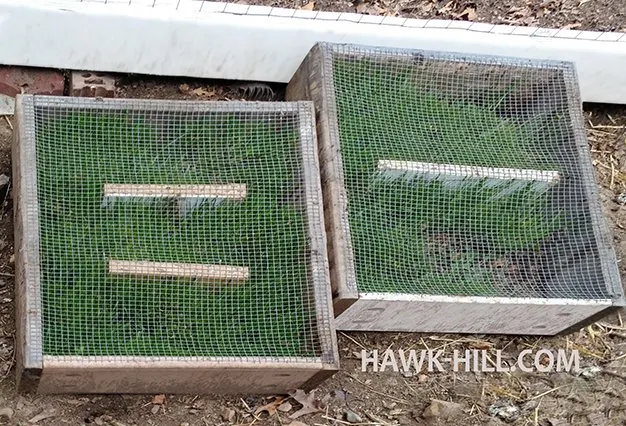
Best Grass Types for Chicken Grazing Boxes:
After trying a few seed types, I was blown away by the success of using oat grass. Oat grass grows in 3 seasons (and even through mild winters!), can be planted without digging or tilling, and has roots strong enough to stay firmly planted in the ground when chicken beaks pull at the shoots of grass reaching through the mesh.
Oat grass is true to its name- it’s just a juvenile version of the plant that produces the familiar oat. A three-pound bag of oat grass seeds marketed for sprouting should cover about 15 plantings of grazing boxes the size shown here (but buying whole oat animal feed in 40lb bags from a local feed store is a better value, if you plan to plant often!). Other unprocessed whole grains can be planted in the boxes, just be sure the grain hasn’t been treated to prevent sprouting, irradiated, or heated to a high temperature to sterilize.
According to Michigan State University: “Oats are a cool-season annual grass that grows well during the fall. Some of those benefits include: forage, weed suppression, nutrient removal, erosion control, and soil softening.” Oats germinate in temperatures as low as 38 degrees F, making them a year-round crop in some areas.
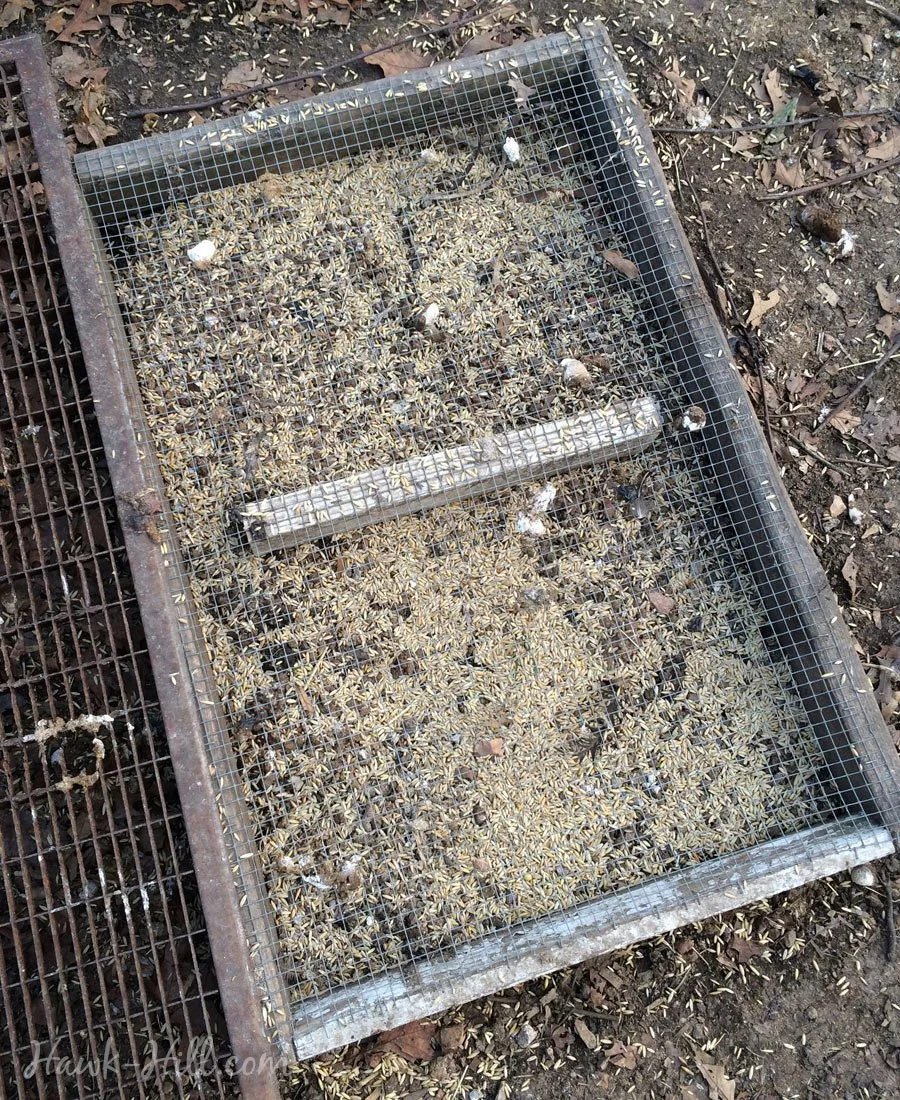
Oat grass in your coop’s grazing boxes has an additional benefit: environmental responsibility. Although we backyard farmers bear much less responsibility than commercial farming operations, it is important to be mindful of the runoff from our coops and the health of our soil. Oat Grass is a tool in this work because it has roots that bind soil and minimize erosion. Additionally, Oat grass is actually used by organic farmers as a “nitrogen catch crop.” Chicken manure is a high-nitrogen organic material, and oat grass – unlike many plants- is not only able to tolerate high-nitrogen soil, but is able to absorb some nitrogen from the soil, lowering the amount of nitrogen in coop-run runoff.
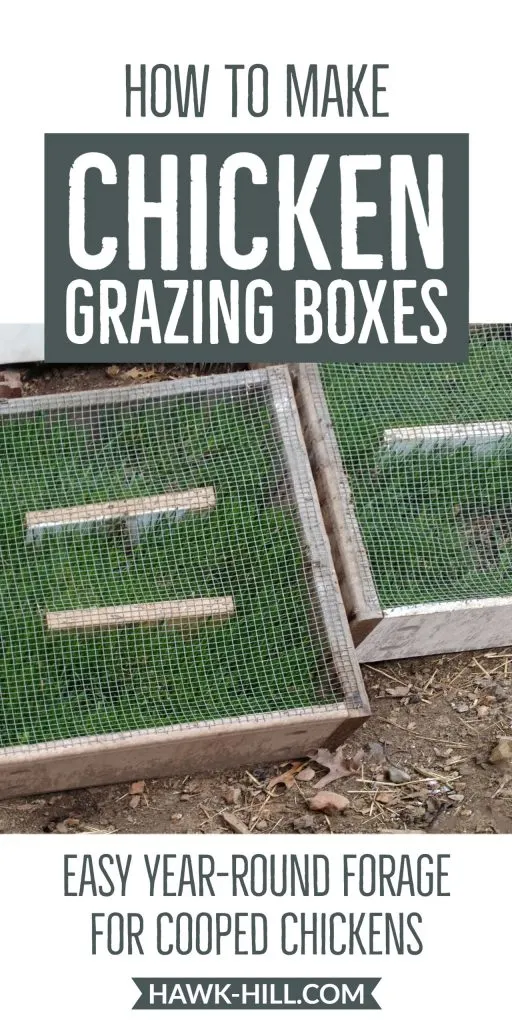
Choosing the right seeds for your Chicken Grazing Boxes
Seeds and grasses that do best in chicken grazing boxes are hardy grasses. I prefer oat grass in my grazing frames because the chickens love the taste and it can germinate at lower temperatures (see above), but you may want to experiment with growing grasses that are native to your region. Growing native grasses is often much easier because the plant has adapted to thrive in our climate and soil.
Believe it or not, grass is an excellent source of nutrition for chickens. Although we are used to feeding hard grains and pelleted feeds to chickens, a diet of grass – and the microorganisms and insects that call a patch of grass home- provide excellent supplemental nutrition for both egg-laying hens and chickens raised for butchering.
Sprouting chicken scratch grains with the grazing box
If you want to give chicken grazing boxes ago without purchasing specialty seed, try sprouting your scratch grains. “Chicken scratch” as it is labeled in most feed stores, is a blend of different seeds that can vary by region and by the feed mill producing that particular brand of chicken scratch. Generally, chicken scratch seeds are not heat-treated or irradiated, meaning they can sprout and grow into the plants that produce them. Many of these seeds can grow into rather large plants that a chicken wouldn’t bother to eat, but a chicken grazing box inside your chicken run can help you sprout these grains into tiny edible nutritional powerhouses for your chickens.
Sprouted grains may offer more accessible nutrition than hard grains, and a grazing box makes it easy to sprout grains for your birds. When you scatter chicken scratch in a grazing box you can choose to either let it grow into small grasses that breach the wire mesh and become a little plant buffet for your chickens, or you can scatter your seed during the rainy season (or, at a time when you can water it every other day or so).
If the seed is kept consistently moist, within about a week your seeds will sprout (usually, even without a soil covering) at this point, you can choose to move the grazing box to a new location, spread more seed, and let you chickens eat the nutritionist sprouted grains left behind.
Best Location for Placing Grazing Boxes:
You can place your grazing frames anywhere your chickens have scratched and pecked an area of earth down to just dirt. You can even place the box in an area of your coop prone to mud and standing water! Mud can be harmful to chickens’ feet, but a grazing box can keep chickens elevated up out of persistent puddles- and even improve drainage in that particular area of your chicken run!
Grazing boxes to Improve Chicken Coop Drainage:
When grasses die, bare earth is exposed, and as that bare earth is trampled by the traffic of chicken feet, the soil becomes compacted and unable to absorb excess moisture. When it rains on this compressed dirt, the water doesn’t soak in- it just sits on top or washes away, taking layers of that dirt with it. In chicken coops with compacted and eroding soil, grazing boxes can help restore a healthy root system.
In the same way that urban “rain gardens,” help prevent storm drain overflow by absorbing and then slowly releasing rainwater, grazing boxes can help slow harmful runoff by providing healthy, aerated soil that can absorb rainwater and release it back slowly. By building a few grazing boxes and moving them to a new area of the coop run with each planting, you can help your entire chicken run have less of an environmental impact. Great drainage is key for animal health and these grazing boxes can be a great win-win solution!
Grazing Frames for Other Animals
You can definitely use grazing boxes for more than just chickens! Although chickens are one of the most grass-aggressive domestic animals, when you have no choice but to keep a grazing animal on a less-than-ideal amount of space, grazing boxes can help you keep fresh grasses available to other types of pets- such as rabbits, ducks, and geese. If using this concept with larger animals, such as ducks, geese, or turkeys you may want to create a stronger frame using recycled metal grates elevated with bricks or pavers :]
Thanks for Reading!!!
I hope you can tell that I love DIY, researching the best affordable solutions for every-day problems opportunities and documenting / sharing solutions!🙌 Hawk-Hill.com is reader-supported.
☕ Hawk-Hill.com is reader-supported. If this article saved you time or money, please consider donating $1 to help me cover the cost of hosting this website OR If you appreciate this information and want to throw a “Thanks!” my way by buying me a coffee – I would Of Course appreciate it! :]
Reader Questions and Recommendations
Readers, do you have any favorite topics / posts? What would you like to read more about in the future? As I hope you can tell from this and other articles on my site, I really enjoy DIY / a good challenge, and I’m not afraid to roll up my sleeves to figure out a great, and hopefully simple 😁 solution. So please feel free to let me know in the comments below (or reach out via social media)!
Ok Really – I’ll try to wrap this up now😂
Finally, if you’d like to continue to learn about interesting DIY options as well as how YOU can tackle creative new projects consider checking out the latest and most popular articles listed on the Hawk-Hill Home Page. I’m always trying to enjoy and write about the creative side of life so please don’t be a stranger – check back often!😍
If you enjoyed this post you may also enjoy reading / perusing / devouring😊 one or all of these articles as well!

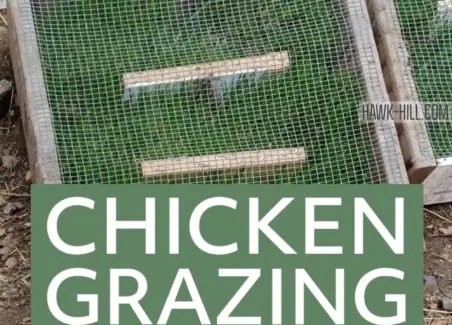
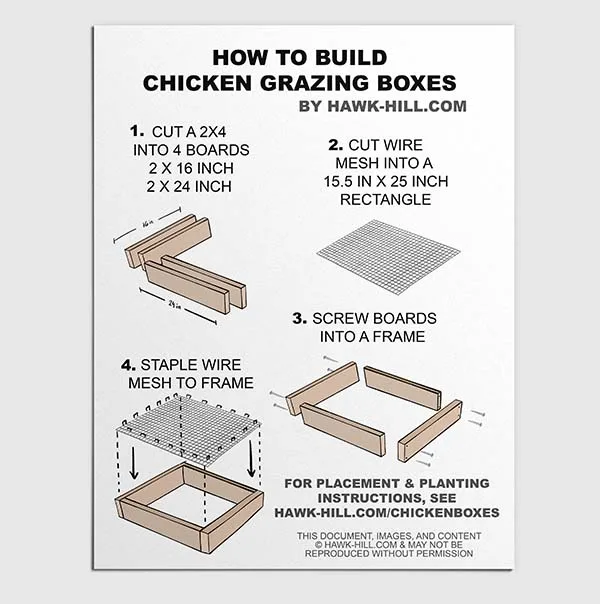
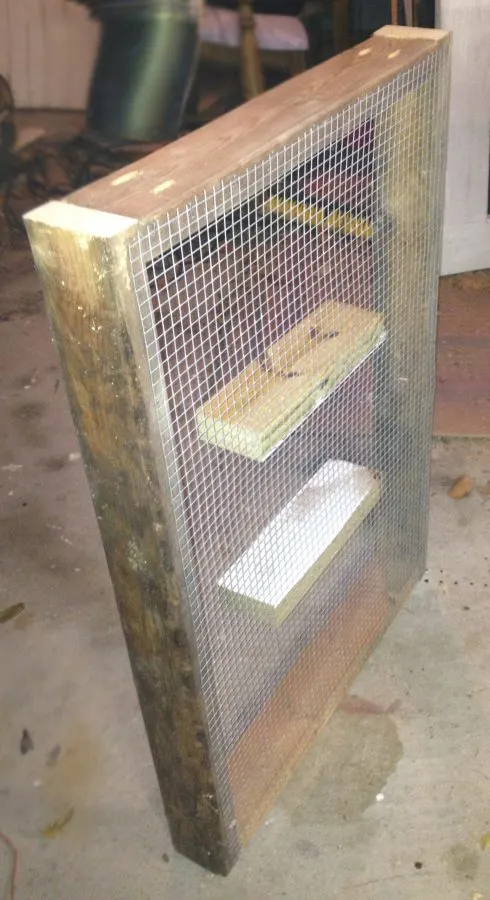
Bill Jones
Thursday 7th of March 2024
I have a chicken run that measures 16’x30’ the chicken coop measures 4’x12’ and is elevated approximately 3’ high using 4”x6” legs to support the coop which is made from pallets and white vinyl siding on 3 of the 4 sides. Right now the coops houses 1 rooster and 5 hens and just purchased 4 Rhode Island Red chicks which will be added to the flock mid April. Under the coop are 2 PawHut automatic feeders each holds 30 lbs of feed. There is also a plastic tray 14”x22” for dust bath. Their water is maintained inside the coop for winter.
On the Grazing frames for planting different grasses. Is there a bottom for the frames. You mentioned early in the post about moving the frames in different areas. How is the soil and grasses moved without disturbing the roots?
Lindsayanne Brenner
Friday 22nd of March 2024
Ah, good question and it sounds like you have a great (large) set up for your chickens! There isn't a bottom to the grazing frames....it allows the roots to remain strong and grow back rather than starting from scratch...if you will. Does that answer your question? Let me know!
elle
Monday 14th of August 2023
Definitely building grazing boxes for my new chicken house. My girls have a shallow chicken spa to cool their little feel in our OK heat. Although curious to them when I filled a shallow pool, they use their chicken spa regularly in the heat. Placed a soil box filled with sandy soil for their dirt baths. Now, fresh winter grass? Wow, will they be happy. Usually, I grow their greens, but I like this better!
Lindsayanne Brenner
Thursday 17th of August 2023
Sounds like you have the full chicken spa! Sounds like a great set up for some very happy chickens :]
Ian
Saturday 6th of August 2022
Hi, In the NE of Eng, UK where we have varying weather from bloody freezing weather to oh its summer and its still 14c. We've had chickens for 11 years now. Pure breed and now bantams (8), silkies, Amber, rock and wyandotte silkie cross. Your site and guidance is a breath of fresh air. Getting ready to make a new coop (built first and then bought a commercial one, never again). 2 doors, DOH! I've a fused ankle so mobility is limited. 2 doors, will make my life so much easier. Have some length of 2x4 so going to knock up graze boxes. Coop is about 15x15x8ft with a third of an acre garden. Graze boxes will be great for winter when they don't want to venture into snow/ice ground. Keep up the stirling advice and thank you for sharing, Ian
Mindy
Tuesday 6th of October 2020
Hi! I live in the desert. My back yard is gravel and a lot of sand. Do I have to till the earth and add soil to it?
Lindsayanne
Tuesday 6th of October 2020
I'm not sure, but it's worth trying on bare sand!
Corrina
Sunday 26th of July 2020
Would this be suitable for ducks? And I know you mentioned oat grass being a nitrogen catch crop, does this mean you leave these grazing patches in the coop all the time or do you take them out so they don’t get completely covered in coop poop.
Lindsayanne
Sunday 26th of July 2020
Hi Corrina! I have not tried it with ducks, but I have had ducks in the past- I think it should work great.
Great questions! They do slowly collect poop on top (duck poop will probably drip through the mesh) so when I'm in the run or cleaning the coop I'll either lift and shake the poop off the frame or use my carpet rake that I use for coop cleaning to sweep it off.
I recommend moving the frame to a new spot, and replanting, every 3-4 months. Oat grass has a fairly short life-cycle and with being constantly nibbled it will eventually run out of energy to keep growing well. A new spot and new seed starts the process all over again and rotates areas of the run getting the benefits of being planted.